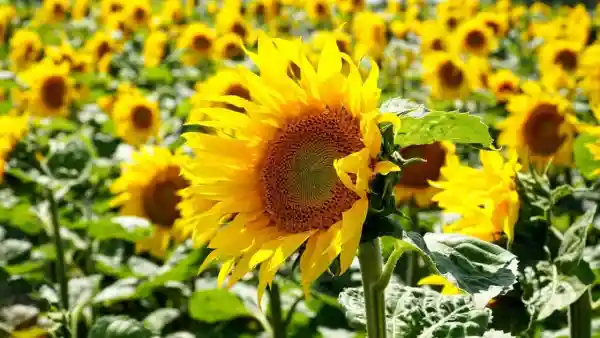Sunflowers, with their radiant blooms and myriad uses, are a beloved addition to gardens and farms. Cultivating and harvesting sunflowers is a rewarding endeavor, but it requires careful attention to their unique requirements. In this expert guide, we’ll provide comprehensive instructions on how to grow and harvest sunflowers successfully, referencing information from reputable government bodies, horticultural organizations, and academic experts.
Introduction to Sunflowers
Sunflowers, scientifically known as Helianthus annuus, are annual plants that produce striking yellow flowers and nutritious seeds. Understanding their growth stages and potential uses is essential before embarking on their cultivation.
Selecting the Right Sunflower Varieties
Consult local agricultural extension offices or the United States Department of Agriculture (USDA) plant hardiness zone map to determine the sunflower varieties best suited for your region. Varieties like “Giant Russian” or “Teddy Bear” have varying heights and uses.
Preparing the Planting Site
Sunflowers thrive in full sun and well-drained soil. Prepare the planting site by removing weeds, tilling the soil, and amending it with organic matter to improve fertility. Check the soil pH, aiming for a range of 6.0 to 7.5, and adjust it if necessary.
Planting Sunflowers
Follow these steps when planting sunflowers:
Spacing and Depth
Sow sunflower seeds at a depth of 1 inch and space them according to the variety, typically 6 to 24 inches apart.
Watering
Water the seeds immediately after planting to ensure good soil contact.
Thin Seedlings
Once the seedlings have a few sets of true leaves, thin them to the recommended spacing, allowing the strongest plants to thrive.
Proper Care and Maintenance
Sunflowers require consistent care throughout their growth:
Watering
Keep the soil consistently moist, but avoid waterlogging, especially during the flowering stage.
Fertilization
Use a balanced, all-purpose fertilizer, adhering to guidelines from your local Agricultural Cooperative Extension for specific recommendations.
Staking
Taller varieties may require staking to support their heavy flower heads in windy conditions.
Harvesting Sunflowers
Harvesting sunflowers involves two stages:
Harvesting for Cut Flowers
Cut sunflowers when the petals start to wilt and the seeds in the center disc are still developing. Remove any excess leaves and place them in water for a vibrant bouquet.
Harvesting for Seeds
Leave the sunflowers to mature until the back of the flower head turns brown, and the seeds appear plump. Cut the flower head, hang it in a well-ventilated area, and remove the seeds when fully dry.
Resources for Further Information
For in-depth knowledge and expert advice on growing and harvesting sunflowers, consult resources provided by horticultural experts and institutions, such as:
United States Department of Agriculture (USDA)
www.usda.gov
Agricultural Cooperative Extension
Your local extension office can provide personalized guidance and resources.
What are sunflowers, and what makes them a popular choice for cultivation?
Sunflowers (Helianthus annuus) are annual plants known for their vibrant flowers and nutritious seeds, making them popular for gardens and farms.
How do I choose the right sunflower varieties for my location and purpose?
Consult local agricultural extension offices and the USDA plant hardiness zone map to select sunflower varieties that suit your region. Different varieties have varying heights and uses.
What is the ideal planting site for sunflowers?
Sunflowers thrive in full sun and well-drained soil. It’s important to prepare the planting site by amending the soil with organic matter and checking the pH level.
When is the best time to plant sunflowers?
Sunflower seeds should be planted in late spring or early summer when the soil is warm and all danger of frost has passed.
What is the recommended spacing and depth for planting sunflower seeds?
Sunflower seeds should be sown at a depth of about 1 inch and spaced according to the specific variety’s requirements.
How should I care for growing sunflowers?
Proper care includes consistent watering, appropriate fertilization, and support for taller varieties through staking.
When is the best time to harvest sunflowers for cut flowers?
Sunflowers for cut flowers should be harvested when the petals begin to wilt but the central seeds are still developing.
How do I harvest and preserve sunflower seeds for consumption?
Sunflower seeds are ready for harvesting when the back of the flower head turns brown, and the seeds are plump. Dry the seeds by hanging the flower heads in a well-ventilated area.
Can sunflowers be grown in containers or small spaces?
Yes, sunflowers can be grown in containers, provided they are large enough to accommodate the root system and receive sufficient sunlight.
Are there specific pests or diseases that commonly affect sunflowers?
While sunflowers are relatively resistant to pests and diseases, some common issues include aphids, birds feeding on seeds, and fungal diseases. Consult local agricultural extension services for guidance on pest and disease management.
- Lip Filler London – Lip Augmentation & Natural Lip Enhancement - December 16, 2025
- Tennessee’s THC Beverage Market - June 5, 2025
- Top THC Infused Seltzers in Delaware - June 5, 2025




